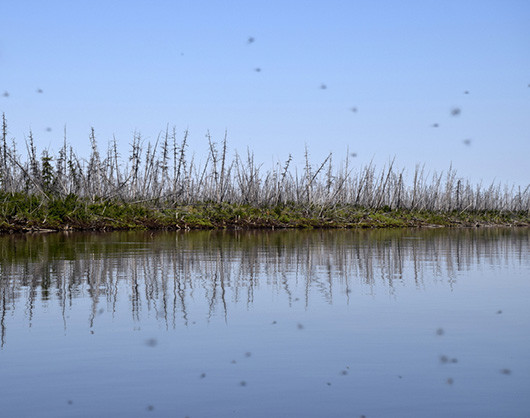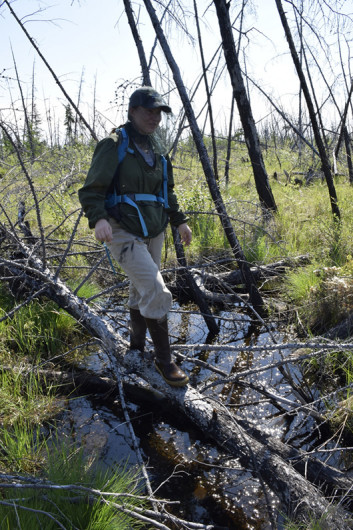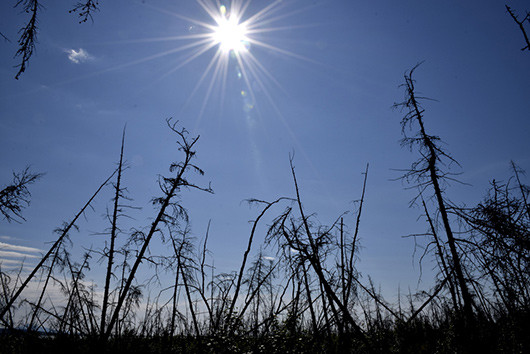
The hellhole. © John Schade
When you trip on a tussock in the tundra, your fall is cushioned by a soft bed of mosses and grasses. The impact is gentle and some might venture to say pleasant. When you trip on a tussock in the “Hell Hole”, cushy mosses are replaced by narrow, limb-bending depressions and the sharp points of broken and charred larch trees. Pleasant is the last word on your mind. As the name may convey, this ten-year old burn site isn’t a simple walk through the park. The fire has left the land a subsided obstacle course scattered with wet and dry depressions to fall in and dead trees to trip over. At the end of a field day I leave bruised, tattered, sweaty, and covered in mosquito bites. But I love it. Every dip and bend of the Hell Hole is interesting, puzzling, and just begging to be studied.

Kenzie Kuhn with a pond formed by land subsidence. © John Schade
Most forested areas are considered sinks for greenhouse gases like methane and carbon dioxide. But the Hell Hole may be different. The fire that has left the Hell Hole looking like a desolate wasteland may be altering microbial processes and the carbon cycle of this forest. Thawed ice wedges and newly depressed and subsided surface areas of the forest allow water to pool in spots that were previously dry. Theoretically, these wet spots are the perfect environment for organisms that produce methane. It is possible that areas that were once a sink for methane could be turned into a source of methane after they subside and are filled with water.
During my last two weeks in “Hell”, I have been sampling and studying these wet depressions in order to better understand their relationship with methane producing organisms and to try and estimate just how much methane is being emitted to the atmosphere from the surfaces of these water bodies. Understanding how the Hell Hole has been affected by the fire in terms of greenhouse gas production could become an important part of our global understanding of the carbon cycle. If the fire at the Hell Hole transformed the forest from a sink of methane to a source of methane, these same processes could happen to other forested areas that undergo fires. As global temperatures increase and the occurrence of fires in high latitude forests also increase, more methane emitted into the atmosphere could further accelerate these processes causing even higher global temperatures and chances of fire. So while most people might think the Hell Hole is an awful place to spend the summer, I couldn’t be happier tripping over trees, falling into holes, and uncovering the Hell Hole’s role in global climate change.

The sun shines over the charred remains of larch trees. © John Schade




Comments(2)-
-
Coach Hodgdon says
July 22, 2015 at 1:56 pmStay safe and keep doing good work Kenzie! We are so proud if you!
Simona Skarecky says
November 16, 2015 at 1:58 amYour blog post reminded me of my grandfather’s memoirs, which I am in the process of translating into English. He was a POW in SIberia (now Kazakhstan) in WW1 and then spent years on the Trans Siberian Railway with the Czech Legion 100 years ago, and described the taiga thus:
” And wherever you can walk on the soft mossy carpet floor, you penetrate deeper into the forest and see cedar, pine, Siberian fir and groups of rare deciduous trees. The taiga is at its widest in eastern Siberia, where it reaches beyond the Arctic Circle in the north, and the border of Mongolia in the south. At that point, the band is 2,000 km wide.
The taiga biome develops and renews itself without human interference, there are no traces of development. It is impossible to orient oneself in the taiga; the light is as dim as twilight and it is alarmingly quiet. Fallen tree trunks lie haphazardly on top of each other, a tangle of underbrush and branches starting just a few metres from the edge of the road or railroad. Not a leaf moves, and your feet sink into the soft ground. Next to a giant pine, larch, or fir, is a weak oak or birch sapling creeping along the ground to block your path. If you lift it up, you find a rotten stump and a broken trunk in your way. You can cross over the trunk but you step into a thorny bush. At times you find a narrow path, but it is surprisingly dangerous; below your feet is a hungry black mud hole, which will swallow up an unsuspecting victim instantly. In addition to these muddy pools, there are still other unsafe bogs located where the ground moisture seeps into dirty yellowish hollows, covered in large, greasy spots full of bubbles – a breeding ground for mosquitoes.
The bushes, like guards at a mysterious castle, cross their sharp spears to stop any intruders. The broken tree trunks are insurmountable barriers, and the invisible bogs under soft moss, which invite you to tread on them, become a trap. All who enter the taiga are defeated. To work your way into it for 100 metres would take at least an hour. The wild forest has its own laws. They are strict, hard, and uncompromising. He who doesn’t heed them, has a cruel enemy in the taiga, which swallows up any daring soul which is then lost forever. The taiga resists, fights back, and puts up unbelievable obstacles. At the steep riverbanks, it stands like a wall. He who wants to enter in has to break the forest wall; without a saw, axe or explosives, no one will get in more than a few steps. The taiga is endless, inaccessible, wild, and devoid of humans, and add to that severe cold or heat, unending distances and impenetrability. ”
You are obviously further north than he was, but some of your description reminded me of his.